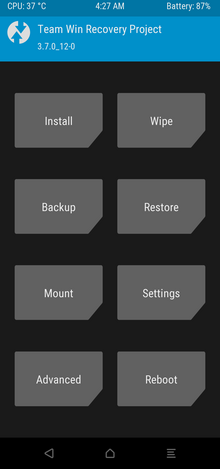TWRP (software)
This articleneeds additional citations forverification.(July 2021) |
 Main screen of TWRP 3.7.0_12-0 | |
| Original author(s) | OmniROM |
|---|---|
| Developer(s) | Team Win |
| Initial release | 13 October 2008[1] |
| Stable release | 3.7.1
/ 21 February 2024[2] |
| Repository | |
| Written in | C++,C,shell,make |
| Operating system | Android |
| Platform | Android |
| Available in | English, Spanish, Russian, Chinese, and others |
| License | GNU General Public License v3[3] |
| Website | twrp |
Team Win Recovery Project(TWRP), pronounced"twerp",[4]is anopen-source softwarecustomrecoveryimage forAndroid-based devices.[5][6]It provides atouchscreen-enabled interface that allows users to install third-partyfirmwareand back up the current system, functions usually not supported by stock recovery images.[6][7][8][9]It is, therefore, often installed when flashing, installing, orrootingAndroid devices,[10]although it does not require a device to be rooted before installation.
Functions[edit]
Since February 2016 the first three digits of the version number specify the version, and the fourth digit, separated from the others by a dash, specifies an update for a specific device. This could be a performance improvement, hotfix, bugfix, or just simply an update for a device.
The main method of installing ( "flashing") this custom recovery on an Android device requires downloading a version made specifically for the device, and then using a tool such asFastbootorOdin.Some custom ROMs come with TWRP as the default recovery image.
TWRP gives users the option to fully back up their device (including bootloader, system data, private applications, etc.) to revert to at any time, and a built-in file manager to delete files that may be causing problems on the device or add some to fix issues.
As of 2019[update],TWRP supported the installation of custom ROMs (i.e. custom operating systems such asLineageOS,or the latest Android release), kernels, add-ons (Google Apps,Magisk,themes, etc.), and other various mods.
Wiping, backing up, restoring, and mounting various devicepartitions,such as the system, boot, userdata, cache, and internal storage partitions are also supported. TWRP also supports file transfer viaMTP,and has a basic file manager and a terminal emulator. It is fully themeable.
In January 2017, the TWRP team released an Android application[11]that allows flashing the recovery using root access. However, unlike the recovery, the app is not open source, although free of charge. This app is also shipped via the official TWRP images to rooted and non-rooted devices. It is installed in the system partition, making it a system-level app by default, so that it cannot be uninstalled from within Android without root access.[12]However, TWRP now provides the user the freedom of choice for having the app.
See also[edit]
- ClockworkMod Recovery– a past alternative to TWRP custom recovery.
References[edit]
- ^"TWRP 1.x".TeamWin. Archived fromthe originalon 28 May 2014.Retrieved20 April2014.
- ^"TWRP Home page, with list of releases".TeamWin.Retrieved26 May2023.Updated as releases added.
- ^TeamWin/android_bootable_recovery,TeamWin, 18 March 2023,retrieved20 March2023
- ^"TeamWin demos TWRP 2.0 recovery manager for Android, scoffs at your volume rocker (video)".Engadget.Retrieved19 September2021.
- ^"TWRP".TeamWin.Retrieved7 February2016.
- ^abHaroon Q Raja (4 May 2013)."What Is TWRP Recovery & How To Install & Use It On Android Devices".AddictiveTips.
- ^Terrence O'Brien (20 December 2011)."Team Win Recovery Project 2.0 goes gold, tells your volume rocker to kiss off".Engadget.
- ^Danny Stieben (12 January 2014)."What's a Custom Recovery? Exploring CWM, TWRP, and Friends".MakeUseOf.
- ^Will Verduzco (10 April 2012)."Team Win Recovery Project Updated to 2.1".XDA Developers.Archived fromthe originalon 25 October 2014.Retrieved20 April2014.
- ^Scott Matteson (31 March 2014)."Rooting your Kindle Fire: a cautionary tale concluded".TechRepublic.
- ^Official TWRP App
- ^TWRP App installation screen
External links[edit]
